
Medicine Containers Page Menu: 1 2 3 4 5 6 7 Next>>
Medicine Containers Used In the Golden Age of Piracy, Page 3
Earthen Containers
While glass appears to have been king in the sea surgeon's
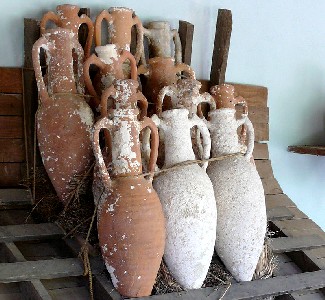
Photo: Ad Meskens
Amphoras Found in Bronze Age Shipwrecks
chest, there were also a variety of earthen containers - typically ceramic - to be found amongst the containers in the chest.
Earthen containers have been around since before recorded history. The use of pottery to create figures, tiles and containers date to the Neolithic Era (roughly 9000 BC - 2000 BC1). Distinctive clay containers called amphora have been found in Bronze Age shipwrecks (in Mediterranean cultures beginning roughly 3000 BC2 - such as Turkey where the photo at right was taken).
These amphora were abundant in early history based on the number that have been found. They were an inexpensive way to haul traded materials such as wine, oils, nuts and similar products. "The form developed in response to the need for a container large enough to hold bulk quantities but small enough to be handled by one person. About a meter high on the average, and weighing about forty pounds when empty, the ancient amphora had two thick handles on each side of a long neck."3
1 "Neolithic Period", www.britannica.com, gathered 9/10/15; 2 "Bronze Age", www.britannica.com, gathered 9/10/15; George Griffenhagen,3 Elizabeth Lyding Will, "The Ancient Commercial Amphora." Archaeology, Vol. 30, 1977, p. 264;
Earthen Containers: The Albarello
Photo: Int'l Museum of Ceramics Faenza
15th Century Albarello
Like glass, records date earthen containers used for medicines back at least to the ancient Greeks and Romans, who employed alabaster and other earthenware.1 Specialized drug containers appear to have originated during the time of Islamic conquests of the Middle East around 634 AD. Persian potters created "a new type of ceramic and a unique style of jar that has been intimately associated with medicines. The innovation in the ceramic art was the use of a tin-glaze to produce a non-porous earthenware, which was much more suitable for storing liquid and semi-liquid medicaments. The unique shaped jar was the albarello, a cylindrical container with concave sides curving inward toward the middle of the jar."2
Early examples of these containers have a large foot and a neck with a thick rim. (The rim would be for sealing the contents with string.) The height of these containers combined with their narrow mouths would have been difficult to fill an ointment without creating air-pockets. As a result, more utilitarian jars that were shorter and had larger openings with less concave waists were created.3
1 George Griffenhagen and Mary Bogard, History of Drug Containers and Their Labels, 1999, p. 3; 2 "Evolution of Drug Containers", Apothecary's Cabinet, No. 8, Fall 2004, p. 5; 3 J.K. Crellin, Medical Ceramics, 1969, p. 92
Earthen Containers: Tin-Enameled Medicine Jars in England
Tin enamel glazes were a necessary step to the creation of effective ceramic medicine jars.
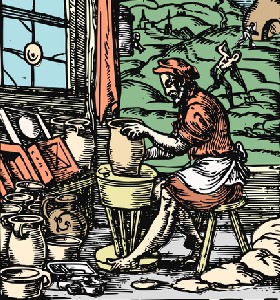
Artist: Jost Amman
Potter (Töpfer), From Das Standebuch (1641)
Without the glaze, the jar was too porous to be suitable as a container of liquid, semi-liquid and oily medicines. Some of the first tin-glazed containers specifically used as drug containers in Europe came from Renaissance Malaga, Spain, established there as a result of Islamic influences.1
The movement of Spanish and Italian potters brought tin-glazing into other locations of the European world. "The art of tin-enameling earthenware was introduced into The Netherlands in the 16th century by Italian potters who settled in Antwerp."2 Manufacture of Dutch tin-glazed pottery took place in Amsterdam, Antwerp, Haarlem, Middleburg, and Rotterdam. "Only during the first half of the 17th century did the town of Delft become such an important centre for the production of 'blue and white' tin-glazed ware" that was associated with it.3 This style of pottery was created "in imitation of the Chinese porcelain, then being imported by the Dutch East India Company."4
Although the exact date such containers began being manufactured in England itself is unknown, in 1567 Antwerp potters Jaspar Andries and Jacob Janson petitioned for permission to make tin-glazed pottery in London. This petition
Photo: Wiki User Daderot
English Delftware Style Jar (1666)
specifically mentioned 'vessels for apothecaries'.5 Tin-glazing potteries eventually sprung up in London, the West Country (Brislington, Bristol, and Wincanton), and Liverpool as well as in Ireland and Scotland.6
Since the industry was started in England by Dutchmen, it should not be surprising that many of these containers were done in the usual Dutch blue and white 'Delftware' style. The white opaque coloring was created by the tin oxide added to glaze for the first firing. The blue color was produced by cobalt oxide, which was added before a second, higher temperature firing. "This design was common to many English drug jars made between about 1650 and 1780."7
In addition to the Delftware style medicinal jars, some porcelain containers were produced in Europe. Although Delftware imitated Chinese porcelain, it wasn't until 1709 that German pharmacist Johann Frederick Boettger determined that kaolin (feldspar) and petuntse (Chinastone) were the fkeys to creating it. Once the recipe was discovered, porcelain began to be manufactured in Meissen, Germany.8 However, it is highly unlikely that a ship's surgeon would have chosen an expensive porcelain container for shipboard use.
1 George Griffenhagen, "Evolution of Drug Containers", Apothecary's Cabinet, No. 8, Fall 2004, p. 5; 2 Griffenhagen, p. 6; 3 J.K. Crellin, Medical Ceramics, 1969, p. 51; 4 Griffenhagen, p. 6; 5 Crellin, p. 1; 6 Crellin, p. 8; 7 P.G. Hoffman, Royal Pharmaceutical Society Information Sheet 14: ENGLISH DELFTWARE STORAGE JARS, 2002, p. 1; 8 Griffenhagen, p. 6-7
Earthen Containers: Gallipots
The most likely earthen container to be found on a ship were gallipots. These are small tin-glazed pots, often used to store ointments and similar medicines. While these utilitarian little pots are commonly excavated in Britain, not all of them would have been manufactured there. Gallipots "were certainly imported from Italy in the 15th and 16th centuries and from Holland in the 17th."1
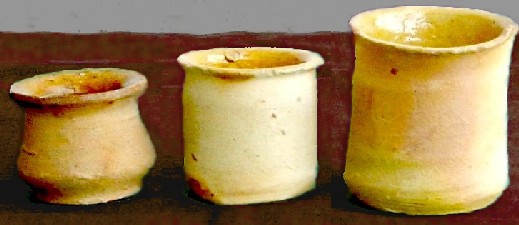
Different Sizes and Styles of Dutch
Gallipots (17th/18th c.)
Historian and pharmacist John Crellin points out that gallipots were not specifically used to house medicinals, but were more all-purpose storage vessels, the use of which can be found in 17th and 18th century cookbooks. He notes that they are "more rough and ready" than the fancy labeled apothecary jars found in the shops. Gallipots were made in various sizes, "holding from about ½ to 2lb. of ointment (approximately 6 x 8 to 10 x 15 cm. in size)."2
Perhaps the most interesting facet of these containers is their name. In the first edition of his dictionary, Samuel Johnson says "the true derivation is from gala, Spanish, finery. Gala, or gally-pot, is a fine painted pot."3 This suggestion is in stark contrast to the function of the little pots; while some of
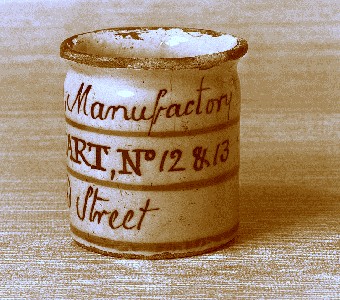
London Gallipot Ointment Jar, From the Wellcome Museum (17th c.)
them were well decorated, the majority seem to have been simple, workaday pots as seen in the images here. Someone may have pointed this out to Mr. Johnson because by the folio edition, this comment was removed and the etymology simply said the word was from "gleye, Dutch, shining earth"4.
As it turns out, this is also incorrect. Word researcher Ernest Weekly points out that the "Dutch glei, potter's earth is a ghost-word [a word used in a dictionary that was rarely actually used in practice], or rather an illegitimate inference from gleipot, the latter being of much more recent date than our gallipot, which is found in the 15th century."5
Different forms of the word 'gallipot' can be dated at least as far back as 1465, when an account from Sir John Howard's household records listed, "Item, the same day my mastyr paid for a galy pott, iij. d [3 pence]"6. Other variations of the word gallipot appear in several places throughout the 16th, 17th and 18th centuries.7
Mr. Weekly goes on to theorize that glei might have thought to be a variant of klei, Dutch for clay. He notes instead that glei is actually "a common 17th-century contraction of galei, earlier galeye, a gally"8. These simple little tin-glazed ceramic pots were probably brought to Europe from the Mediterranean in galleys, thus the name 'galley-pot'9. It is likely that other such tin-glazed ceramic items were called by similar names; the 1538 century dictionary of syr Thomas Eliot knyght defines a culullus as "an erthen cup, suche as the galye cuppes be."10
1,2 J.K. Crellin, Medical Ceramics, 1969, p. 11; 3 Samuel Johnson, 'Gallery to Gallop', A Dictionary of the English Language: In which the Words are Deduced from Their Originals, and Illustrated in Their Different Significations by Examples from the Best Writers, to which are Prefixed, a History of the Language, and an English Grammar, Volume 1, 1755, not paginated; 4 Samuel Johnson, 'Gallimatia to Gang', A Dictionary of the English Language, 3rd Edition, Volume 1, 1756, not paginated; 5 Ernest Weekley, More Words Ancient and Modern, 1927, p. 56-7; 6 W. Nichol, Manners and Household Expenses of England in the Thirteenth and Fifteenth Centuries: Illustrated by Original Records, Volume 1, 1841, p. 285; 7 For a list of references to the word after the 15th century, see Weekly, p. 56-7 & Joseph Marryat, A History of Pottery and Porcelain, Mediæval and Modern, 1868, p. 490; 8 Weekly, p. 56; 9 "gallipot, " www.oxforddictionaries.com, gathered 8/23/15; 10 Sir Thomas Elyot, the dictionary of syr Thomas Eliot knyght, 1538, p. XXVIII
Earthen Containers: Uses
Tin-glazed containers were used for a variety of medicinal purposes. They were frequently mentioned as containers for ointments, electuaries, and similar medicines. Ceramic jars were sometimes made for liquids, such as oils. However, historian J.K. Crellin points out that ceramic oil jars are "the least common of the tin-glazed jars, are generally similar to the ointment jar with the addition of a flanged
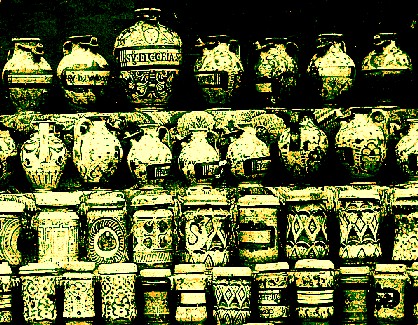
A Variety of Ceramic Pharmacy and Other Jars from the Wellcome Collection
spout and handle"1. In addition, a few small, bulbous jars for pills have been found, but the number found suggest these may not have been common.
Physician Nicholas Culpeper suggested earthen containers were suitable for containing a variety of different classes of medicines. He explains that syrups2 and oils3 could be kept either in glass containers or 'stone' pots. He more directly states that electuaries4, lohochs5 [thick, syrupy concoctions] and troches [lozenges]6 were to be kept 'in a pot', most likely referring to ceramic pots. For conserves, Culpeper is even more specific, "the way of keeping them, is in Earthen Pots."7 He doesn't specify that the such pots be tin-glazed, although it would have been necessary given the viscous nature of a conserve. He later specifies that if they are not kept in glass containers, preserves are to be kept in "glassed [glazed] pots."8
French physician Jean de Renou recommends earthen vessels for a few medicine as well. He explains that turpentine may be kept "in a figuline [pottery container]", syrups in "Potters vessels" and liquid electuaries [medicines made with sweet substances such as honey] in "Vessels well leaded [glazed]"9. These generally agree with Culpeper's assessments.
Fellow French physician Pierre Dionis once again provides images of a variety of ceramic containers,
mentioning them in his operation explanations without going into a lot of detail about their makeup. Those most relevant to medicine containers are seen below. It should be noted that Dionis, Renou and Culpeper were suggesting such containers for use in a stationary, land-based practice.
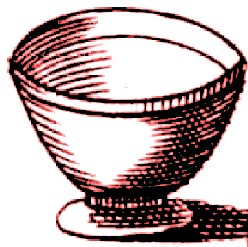 Possible Ceramic Oil of Roses Container, From Pierre Dionis' Cours d'Operations de Chirurgerie, p. 239 (1708) |
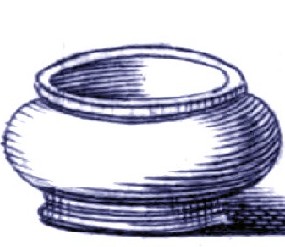 Ceramic Balm Container (reminiscent of a gallipot), From Pierre Dionis' Cours d'Operations de Chirurgerie, p. 606 (1708) |
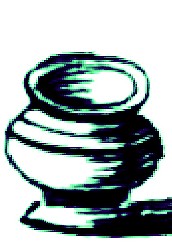 Ceramic Opiate Container, From Pierre Dionis' Cours d'Operations , p. 414 (1708) |
Three authors specifically mention keeping extracts in gallipots. Physician William Salmon recommends keeping extract of colquintida [Citrullus colocynthis] moistened "with Chymical Oyl of Limons, or Caraways, and so keep it in a Jarglass or Galley-pot, tyed close over with a wet Bladder, for Use."10 Physician Thomas Fuller recommends putting Electuary of Mistletoe "in a Gally-pot, tied over very close with a Bladder."11 Military surgeon William Fabry, when describing a medicine chest for military land and sea use, says that "Manna and Cassia extracted ...may more conveniently be kept; in Galli-pots"12.
Fabry recommends gallipots for use in containing a couple of other medicinals. He advises that "Purging Electuaries... are to be kept in Galli-pots"13 and "Unguents, and Fats are best kept in Galli-pots, or [containers] of Pewter, well tied down with Paper and Leather. And Turpentine so likewise."14
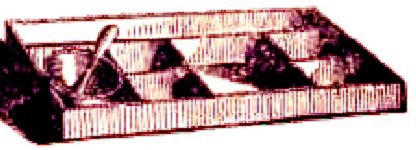
A Plaster Box, Salvatory or Dressing Box (Depending on Who You Ask)
In addition to the medicine chest, Fabry also tells his readers "a Chirurgeon ought always to have about him... a Salvatory [a box] with six divisions,
which ought to be furnish'd 1. with unguentum Basilicon, 2. with ung. Aureum, 3. Apostolorum, 4. Nutritum, 5. Album Rhasis, the 6. with Rubrum Exsiccativum, or de Minio"15. Sea surgeon John Moyle refers to a similar "dressing Box (that is a
box with six or eight partitions with Pots or Glasses of Oyles or Balsams, and Emplasters, ready spread for present occasion"16. Although neither provide details on the makeup of the 'Pots' in these boxes, we can infer this from Fabry's previous recommendation that unguents and electuaries be kept in pewter or tin-glazed earthen gallipots.
Our sea surgeon authors also mention ceramic containers for use in keeping medicines. Naval surgeon John Atkins mentions that once a surgeon is warranted [given his station by warrant - surgeons were warrant officers in the British Royal
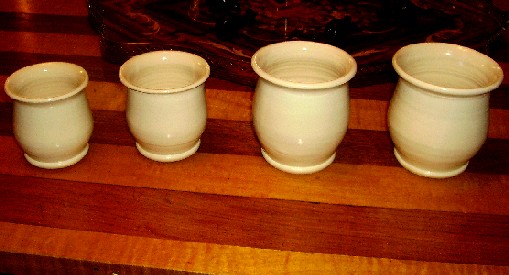
The Author's Reproduction Gallipots, Made by J. Henderson Artifacts
Navy], he should acquire the things he needed for his station including 'Pots'17. Atkins doesn't specify the material, but gallipots, glass pots and pewter pots are all possible candidates. While John Woodall doesn't provide a wealth of information on medicine container materials, he does mention that boiled barleys and wheat flower should be kept "in some earthen or glasse vessel"18.
When discussing the carrying of a variety of medicinals for the same purpose, John Moyle explains, "I do not say you should carry many [medicines] of the same form and effect, but one pot or glass, or mass of each form, but of the same effect, is sufficient, or two at most."19 Again, the material of the little medicine 'pot' is not given, we can infer that it would be of ceramic or pewter.
Moyle does mention gallipots, but only in a negative sense. When explaining ways to preserve medicines, he says, "For this end [preserving your medicine] you had better have square double Glass Jars and Bottles, than Gallipots; for these will fit the partitions in your Chest better than the others, and indeed will preserve your Medicines cooler and better."20 From this, it appears that while his salvatory may have contained ceramic pots, his medicine chest would most likely be stocked with glass containers.
1 J.K. Crellin, Medical Ceramics, 1969, p. 10; 2 Nicholas Culpeper, The English Physitian Enlarged, 1666, p. 275; 3 Culpeper, p. 278; 4 Culpeper, p. 279; 5 Culpeper, p. 281; 6 Culpeper, p. 279; 7 Culpeper, p. 279; 7 Culpeper, p. 281; 9 Jean de Renou, A Medicinal Dispensatory, 1657, p. 146; 10 William Salmon, Pharmacopoeia Bateana, 1710, p. 274; 11 Thomas Fuller, Pharmacopœia extemporanea, 1719, p. 133; 12 Guiliem. Fabritius Hildanus aka. William Fabry. Cista Militaris, Or, A Military Chest, Furnished Either for Sea or Land, 1674, p. 9; 13 Fabry. p. 9-10; 14 Fabry. p. 11; 15 Fabry. p. 23-4; 16 John Moyle, Abstractum Chirurgæ Marinæ, p. 20; 17 John Atkins, "Introduction," The Navy Surgeon, not paginated; 18 John Woodall, the surgions mate, 1617, p. 36; 19 John Moyle, The Sea Chirurgeon, 1693, p. 6; 20 Moyle, Sea Chirurgeon, p. 41

